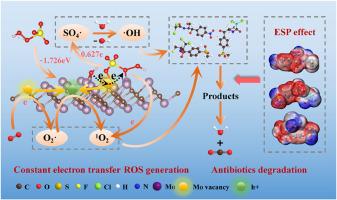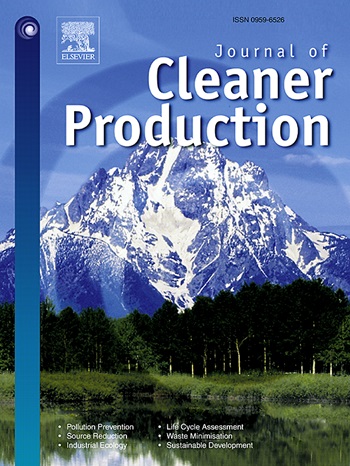Hydroxyl groups and vacancy defects modified Mo2C MXene as peroxymonosulfate activator for antibiotics degradation
IF 10
1区 环境科学与生态学
Q1 ENGINEERING, ENVIRONMENTAL
引用次数: 0
Abstract
Antibiotic pollution poses significant threats to ecological health and food safety, highlighting the need for effective pollution control strategies. A novel Mo2C MXene-OH&VMo (hydroxyl groups and Mo vacancy defects modified Mo2C MXene) was developed through etching and hydrothermal methods, which facilitated the construction of a degradation system utilizing peroxymonosulfate for antibiotics degradation. The MXene-OH&VMo demonstrated enhanced adsorption of HSO5−, achieving an adsorption energy of -1.73 eV, which is superior to that of unmodified Mo2C MXene (-0.42 eV). The activation of HSO5– by Mo vacancies involved the transfer of 0.63 e, leading to the generation of reactive oxygen species (•OH, 1O2, SO4•− and O2•−) responsible for degrading three antibiotics with degradation percentages exceeding 97.00%. The presence of hydroxyl groups further improved the activation efficiency of HSO5− by optimizing the electron arrangement of Mo2C MXene-OH&VMo. The extent of antibiotic degradation was influenced by atomic charge distribution. Additionally, Mo2C MXene-OH&VMo exhibited remarkable repeatability, maintaining degradation percentages above 88.00% after four cycles. The condensed Fukui function was utilized to identify highly active sites of antibiotics, and combined with degradation products analyzed by HPLC-MS/MS, commonalities in detailed degradation pathways were revealed. Furthermore, the products were found to pose negligible toxicity risks to ecological receptors and humans. These findings hold significant implications for the future use of MXene-based catalyst advanced oxidation technology in the treatment of organic pollutants and offer sustainable solutions for environmental remediation. Insights into the development of new catalysts through surface modification engineering were also presented in this study.

羟基和空位缺陷修饰Mo2C MXene作为抗生素降解过氧单硫酸活化剂
抗生素污染对生态健康和食品安全构成重大威胁,迫切需要有效的污染控制策略。通过蚀刻和水热法制备了一种新型Mo2C MXene- oh&;VMo(羟基和Mo空位缺陷修饰的Mo2C MXene),促进了过氧单硫酸酯降解体系的构建。MXene- oh&;VMo对HSO5−的吸附能力增强,吸附能达到-1.73 eV,优于未改性的Mo2C MXene (-0.42 eV)。Mo空位对HSO5 -的激活涉及0.63 e的转移,导致生成活性氧(•OH, 1O2, SO4•−和O2•−),降解3种抗生素,降解率超过97.00%。羟基的存在通过优化Mo2C MXene-OH&;VMo的电子排列,进一步提高了HSO5 -的活化效率。抗生素的降解程度受原子电荷分布的影响。此外,Mo2C MXene-OH&;VMo具有显著的重复性,在四个循环后,降解率保持在88.00%以上。利用浓缩的Fukui函数识别抗生素的高活性位点,并结合HPLC-MS/MS分析的降解产物,揭示了详细降解途径的共性。此外,这些产品对生态受体和人类的毒性风险可以忽略不计。这些发现对未来mxene催化剂高级氧化技术在有机污染物处理中的应用具有重要意义,并为环境修复提供了可持续的解决方案。本研究还提出了通过表面改性工程开发新型催化剂的见解。
本文章由计算机程序翻译,如有差异,请以英文原文为准。
求助全文
约1分钟内获得全文
求助全文
来源期刊

Journal of Cleaner Production
环境科学-工程:环境
CiteScore
20.40
自引率
9.00%
发文量
4720
审稿时长
111 days
期刊介绍:
The Journal of Cleaner Production is an international, transdisciplinary journal that addresses and discusses theoretical and practical Cleaner Production, Environmental, and Sustainability issues. It aims to help societies become more sustainable by focusing on the concept of 'Cleaner Production', which aims at preventing waste production and increasing efficiencies in energy, water, resources, and human capital use. The journal serves as a platform for corporations, governments, education institutions, regions, and societies to engage in discussions and research related to Cleaner Production, environmental, and sustainability practices.
 求助内容:
求助内容: 应助结果提醒方式:
应助结果提醒方式:


